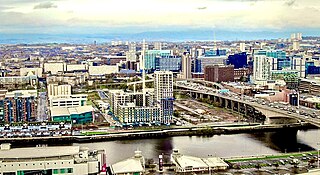
A station wagon or estate car, is an automotive body-style variant of a sedan with its roof extended rearward over a shared passenger/cargo volume with access at the back via a third or fifth door, instead of a trunk/boot lid. The body style transforms a standard three-box design into a two-box design—to include an A, B, and C-pillar, as well as a D-pillar. Station wagons can flexibly reconfigure their interior volume via fold-down rear seats to prioritize either passenger or cargo volume.

The Maybach 57 and 62 were the first automobile models of the Maybach brand since its revival by DaimlerChrysler AG. They are derived from the Mercedes-Benz Maybach concept car presented at the 1997 Tokyo Motor Show. The concept car was based on the Mercedes-Benz W140 S-class sedan platform, as were the production models. The Luxury Brand Status Index 2008 placed the Maybach in first place, ahead of Rolls-Royce and Bentley. The models ceased production in February 2013 due to continued financial losses for the brand, with sales at one-fifth the level of the profitable Rolls-Royce models.

A barrel or cask is a hollow cylindrical container with a bulging center, longer than it is wide. They are traditionally made of wooden staves and bound by wooden or metal hoops. The word vat is often used for large containers for liquids, usually alcoholic beverages; a small barrel or cask is known as a keg.

The Mercedes-Benz G-Class, colloquially known as the G-Wagen is a four-wheel drive automobile manufactured by Magna Steyr in Austria and sold by Mercedes-Benz. Originally developed as a military off-roader, later more luxurious models were added to the line. In certain markets, it was sold under the Puch name as Puch G until 2000.

The Mercedes-Benz Sprinter is a light commercial vehicle (van) built by Mercedes-Benz Group AG of Stuttgart, Germany as a large van, chassis cab, minibus, and pickup truck. In the past, the Sprinter had been sold under the Mercedes-Benz, Dodge, and Freightliner nameplates. In the U.S., it was built from complete knock down (CKD) kits by Freightliner. Re-badged and re-engined Sprinters were also sold by Volkswagen Commercial Vehicles as the Volkswagen LT and the Volkswagen Crafter. They are now primarily marketed by Mercedes-Benz.

Anderston is an area of Glasgow, Scotland. It is on the north bank of the River Clyde and forms the south western edge of the city centre. Established as a village of handloom weavers in the early 18th century, Anderston was an independent burgh of barony from 1824 until it was incorporated into the City of Glasgow in 1846.

Liverpool Salvage Corps was a service in Liverpool, England, founded and maintained by fire insurers, whose aim was to reduce the loss and damage caused by fires, to help mitigate the effects of fire and of fire-fighting and to salvage both premises and goods affected by fire. It was founded in 1842 and operated until April 1984, when its functions were transferred to the Merseyside Fire Brigade. Similar salvage corps also operated in London and Glasgow.

The Mercedes-Benz W221 is a chassis code of the fifth generation S-Class produced from August 2005 until June 2013.

The Mercedes-Benz "Ponton" series is a range of sedans / saloon car models from Daimler-Benz, introduced starting in 1953, and subsequently nicknamed 'Ponton', referring to its ponton styling, a prominent styling trend that unified the previously articulated hood, body, fenders and runnings boards into a singular, often slab-sided envelope. At the time, Mercedes itself did not refer to any of its cars using the nickname.

The London Salvage Corps was maintained by the fire offices of London. The corps was first formed in 1865 and began operations in March 1866. It was inspired by the Liverpool Salvage Corps which had been formed in 1842, to reduce the loss and damage caused by fires, to help mitigate the effects of fire and of fire-fighting and to salvage both premises and goods affected by fire.

The Rheinmetall LandSysteme Light Infantry Vehicle for Special Operations, or LIV (SO), is a German light armoured utility vehicle based on the Mercedes-Benz G-Class. It is also known by the names Serval, Wolf, and AGF. As the name implies, the LIV (SO) is designed specifically for use by special operations forces, and has light armour, high mobility and high firepower. Development of the vehicle started in 2002, and 21 were procured by the German Army for the KSK special forces in 2004. An unspecified number of vehicles were delivered to the Swiss Army in 2007.

Powers is a brand of Irish whiskey produced by the Irish Distillers subsidiary of Pernod Ricard. Historically a single pot still whiskey, the flagship Powers Gold Label brand was the first Irish whiskey ever to be bottled. Powers Gold Label was the best-selling whiskey in Ireland.
Edward Butler (1862–1940) was an English inventor who produced an early three-wheeled petrol automobile called the Butler Petrol Cycle, which is accepted by many as the first British car.
Salvage Corps came into existence in the 19th century. With the growth of cities, fires and insurance, underwriters in several cities established fire fighting services to reduce losses. As municipal fire brigades became more competent in the 20th century, the private fire companies cut back their services and emphasised salvaging property after the regular firemen had done their job.

The Panhard M3 VTT is an amphibious armoured personnel carrier. Developed as a private venture for the export market, the M3 was built with the same mechanical and chassis components as the Panhard AML range of light armoured cars. The two vehicle types share a 95% interchangeability of automotive parts. The M3 is an extremely versatile design which can be configured for a wide variety of auxiliary battlefield roles. The most popular variants of the base personnel carrier included an armoured ambulance, a mobile command post, and an internal security vehicle. It could also be fitted with a wide variety of turrets and armament, ranging from a single general-purpose machine gun to medium calibre autocannon.

The Bedford RL was the British military's main medium lorry, built by Bedford from the mid-1950s until the late 1960s. The lorry was based on the civilian Bedford S type, first introduced in 1950. They superseded the Bedford QL, and were in turn superseded by the Bedford MK/MJ.
The Cheapside Street whisky bond fire in Glasgow on 28 March 1960 was Britain's worst peacetime fire services disaster. The fire at a whisky bond killed 14 fire service and 5 salvage corps personnel. This fire was overshadowed only by a similar fire in James Watt Street on 19 November 1968, when 22 people died.
The Bullet Troop-Carrying Vehicle (TCV) is a light 4x4 infantry fighting vehicle (IFV) developed by Rhodesia in the late 1970s based on the body of the Mercedes-Benz Unimog light truck.
The Kilbirnie Street fire, on Friday 25 August 1972, was a warehouse fire in the Port Eglinton area, on the south side of Glasgow, Scotland, which killed seven Glasgow Fire Service firemen in a flashover while they were trying to rescue a trapped colleague. What started as a routine industrial premises fire resulted in one of the highest losses of life for the UK Fire Service at a single incident in peacetime.
Glasgow Fire Service provided emergency services such as fire prevention, firefighting, emergency medical services and technical rescue to Glasgow, the largest city in Scotland and the third-largest city in the United Kingdom. On 16 May 1975, the Glasgow Fire Service was absorbed into the now defunct Strathclyde Fire and Rescue Service.

















